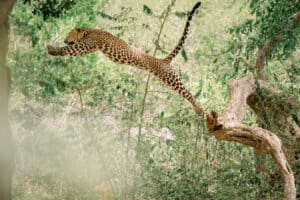New World monkeys are a type of monkeys native to the Americas. They are “new” because their discovery is relatively new compared to Old World monkeys living in Africa and Asia. New World monkeys fall into five families: Callitrichidae, Cebidae, Aotidae, Pitheciidae, and Atelidae. There are over 60 New World monkey species, including the capuchin monkey, the marmoset, and the howler monkey.
New World monkeys are typically smaller than Old World monkeys and have longer tails. Because of their tails, they are also more likely to live in trees than on the ground. In addition, New World monkeys are omnivorous, meaning they eat plants and animals. Some of the most popular foods for New World monkeys include fruits, insects, and small vertebrates. Let’s look closely at these 9 types of New World monkeys.
1. Gracile Capuchin
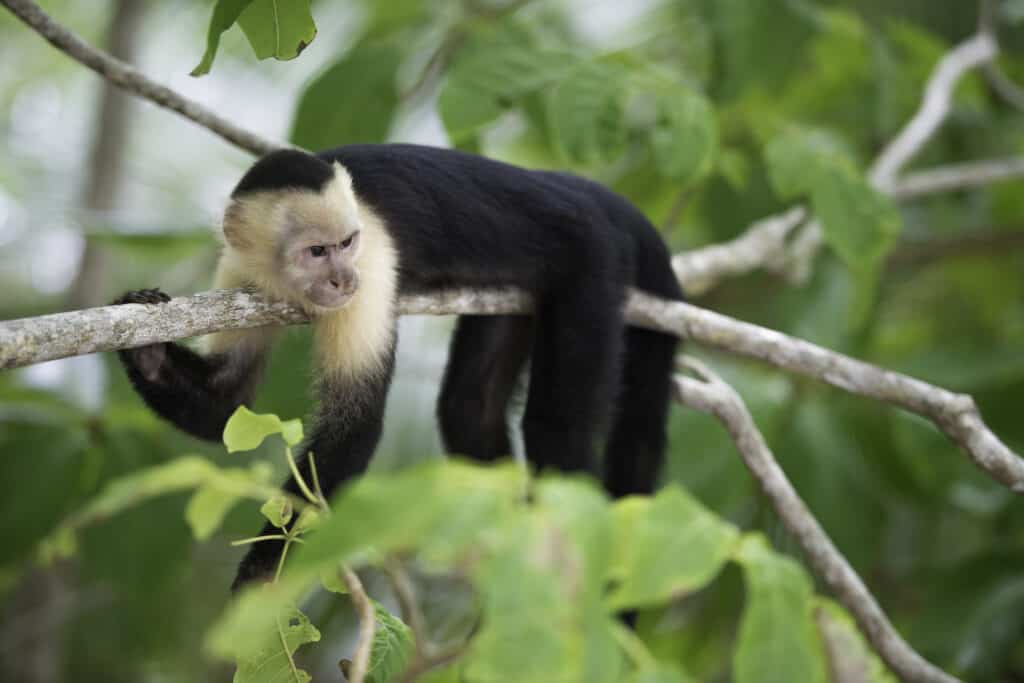
Gracile capuchin monkeys have white fur on their bellies.
©iStock.com/olm26250
Gracile capuchin monkeys (genus Cebus) live in the tropical rainforests of South America, inhabiting the forests of Brazil, Bolivia, Colombia, Ecuador, Peru, and Venezuela. They are arboreal animals, so they live most of their lives high in the trees.
Gracile capuchin monkeys are small, with a weight of 3–9 pounds. They have white fur on their bellies and lower legs, with the rest of their body a dark brown or black color. Their tails are long and slim, and their faces are bare with black patches around their eyes.
Gracile capuchin monkeys are omnivorous, so they eat plants and animals. Their diet consists of fruits, leaves, nuts, seeds, insects, spiders, and small mammals. Additionally, they use tools to help them find food, such as using sticks to probe for termites or rocks to crack open a nutshell.
Gracile capuchin monkey troops comprise related females and their young, with adult males living alone or in small groups. The females and young form the group’s core, with the males only joining them to mate.
2. Night/Owl Monkey

Owl monkeys have owl-like faces with enormous round eyes.
©Edwin Butter/Shutterstock.com
One of the most fascinating and unusual monkeys is the night monkey, or owl monkey. As its name suggests, this monkey is most active at night, making it one of the few nocturnal primates. However, it is an unusual creature adapted well to its nocturnal lifestyle. The night monkey inhabits the tropical rainforests of Central and South America, spending most of its time high up in the trees.
Night monkeys are small to medium, with males and females reaching a maximum weight of around six to seven pounds. Their bodies grow to between 10 and 14 inches long, and their non-prehensile tails grow longer than their bodies.
Their coats are dark brown or black, which helps them blend in with the darkness and avoid being seen by predators. They have owl-like faces with enormous round eyes. Their eyes feature monochromatic vision, enabling clear night vision, although they are also essentially color blind.
Owl monkeys eat bats, birds, insects, and fruit if necessary. These primates are also arboreal and live on tree tops high in the forest canopy. They are timid and elusive, and humans seldom see them.
3. Titi Monkeys

Titi monkeys have long tails and silky fur.
©iStock.com/guy-ozenne
Titis are small to medium-sized monkeys living in South America’s tropical forests. These monkeys are known for their long tails and silky fur, which can be either black or reddish-brown. Their broad, round faces with large eyes also characterize them. Males and females look pretty similar, although males tend to be slightly larger than females.
Titi monkeys typically live in pairs or small groups. They are often seen swinging through the trees or climbing on branches. These monkeys are tree-dwellers but occasionally come down to the ground to forage for food. They consume fruits and leaves but will also eat insects and small vertebrates.
Titi monkeys occupy the tropical forests of Brazil, Bolivia, Colombia, Ecuador, Peru, and Venezuela. They typically inhabit lowland rainforests and mountain forests up to 9,842 feet.
As deforestation and other human activities continue to destroy their natural habitats, Titi monkeys are increasingly under threat of extinction. People hunt them for their fur and body parts, and the illegal pet trade also contributes to the decline of these animals.
4. White-faced Saki

Male white-faced saki monkeys have white faces, while females have grey, brown, or red faces.
©iStock.com/Ondrej Prosicky
White-faced saki monkeys (Pithecia pithecia) are small monkeys with distinctive white faces. Both gender sizes are similar, measuring around 12.5 to 16 inches long from head to tail. They can weigh between 3 and 5.2 pounds. Gray or brown fur covers their bodies, except for the characteristic white facial area. However, only the males have white faces while females have gray, brown, or red faces. In addition, they have black hands and feet and long tails proportionate to their body length.
White-faced saki monkeys live in the tropical forests of South America. They are most common in Brazil, Guyana, Suriname, Venezuela, Colombia, Peru, and Ecuador. These New World monkeys typically live in small groups of around four to five individuals. Still, people have seen them living in groups of up to 20.
White-faced saki monkeys eat mainly fruit but will also eat leaves, flowers, insects, and other small animals. These monkeys are pretty aggressive in defending their food sources and territories.
5. Howler Monkey
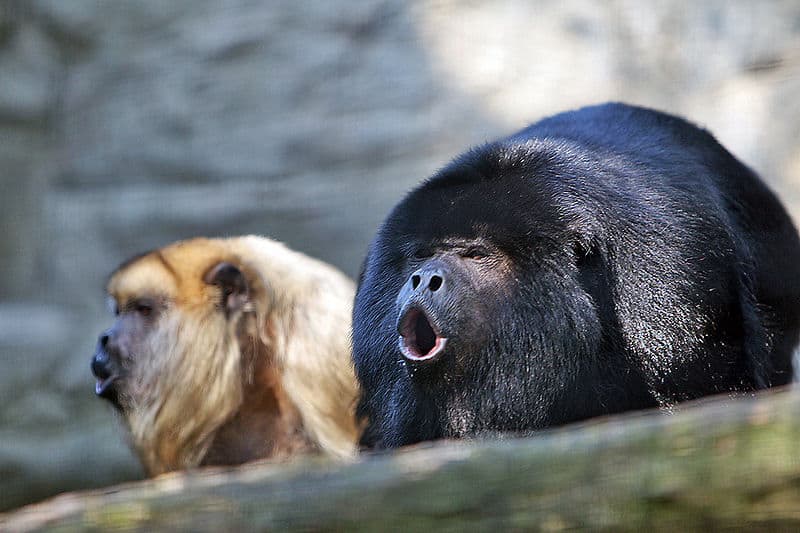
Howler monkeys have long, prehensile tails, which they use as a powerful fifth limb when climbing.
Howler monkeys are large New World monkeys native to Central and South America. They get their name from their loud howls or calls, which you can hear up to three miles away. Howler monkeys are the largest in the Americas and have a body length of up to 36 inches and weigh up to 22 pounds. Females are generally smaller than males. Howler monkeys have long, prehensile tails of about 23 to 36 inches, which they use as a powerful fifth limb when climbing.
Howler monkeys have bearded faces and are generally black, brown, or reddish. However, there are 15 different howler monkey species, each with slightly different coloration.
Howler monkeys live in tropical rainforests and spend most of their time in the trees. These monkeys live in larger groups than is the norm for New World monkeys, often seen in troops of up to 20 individuals. Males leave their troops when they mature, form their own troops, or become solitary.
Howler monkeys are herbivores whose diet consists of leaves, flowers, fruit, and nuts. They can digest these tough plant foods due to particular stomach adaptations. These New World monkeys play a vital role in their ecosystem with their messy eating habits, helping to disperse plant seeds as they eat.
6. Uakari

The uakari’s distinctive physical feature is its bright red face.
Uakaris are small to medium-sized monkeys living in South America’s rainforests. They have reddish-brown or black fur, and their distinctive physical feature is their bright red faces. These primates are about 15-22.5 inches long, excluding their tails, up to 24 inches. They weigh between 4.4 and 6.6 pounds.
These species live in the rainforests of Brazil, Colombia, Ecuador, Peru, and Bolivia. In addition, they occupy areas of lowland tropical forests, swamp forests, and gallery forests (forests that grow along rivers). Uakaris are mostly arboreal but are also good swimmers and often swim in rivers.
Uakaris are omnivorous with a diet of fruit, leaves, insects, small mammals, and birds. These primates create small troops, including related females, juveniles, and a few adult males. They birth one baby at a time after mating and a gestation period of about six months.
The uakari is diurnal and has a life span of about 20 years.
7. Muriqui
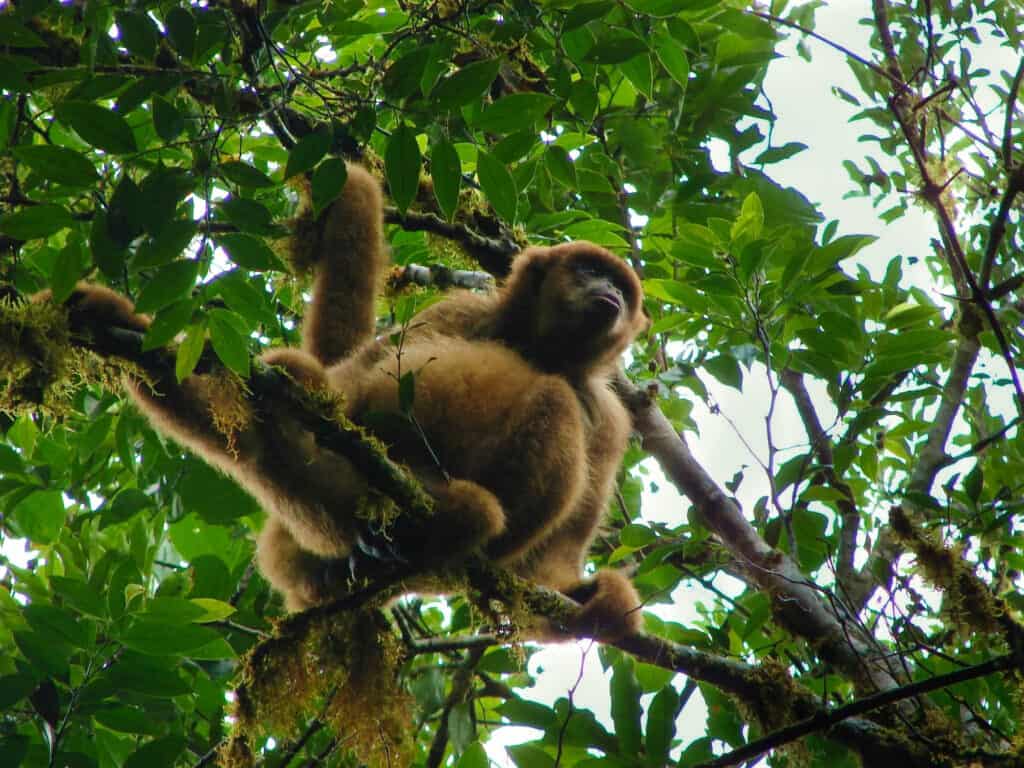
Muriquis do not have opposable thumbs.
©iStock.com/Leonardo Desordi Lobo
Muriquis, also known as woolly spider monkeys, are primate species in the Atlantic Forest of Southeast Brazil. They are among the largest spider monkeys, with males weighing up to 33 pounds and females up to 22 pounds. Muriquis have long hair covering their entire body, including their tail. They are gray or yellowish-brown, with a silvery appearance due to highlights of lighter-colored hair. In addition, they have a reddish-brown patch on their chest and hairless faces.
These primates fall into two groups, Southern and Northern. The difference is that the southern muriqui has an entirely black face. At the same time, its Northern counterpart sports a mottled look with pink pigments. Also, the Southern muriqui has no external thumb, yet the Northern muriqui does. Still, it is a rudimentary one that is much smaller than other primates with opposable thumbs.
The natural habitats of these primates extend along the coast of Brazil from northern Bahia to the southern Rio Grande do Sul. They inhabit both primary and secondary forests, as well as gallery forests.
Muriquis are arboreal and diurnal.
Muriquis live in close-knit groups of related females, their young, and a few adult males. These New World monkeys are omnivorous, with diets consisting of fruit, leaves, flowers, buds, insects, and spiders.
8. Woolly Monkey (Lagothrix)

Brown woolly monkeys have long, dense black or brown fur.
©Evgenia Kononova – Public Domain
The woolly monkey is a primate of the family Atelidae, endemic to South America. It comprises the following two species:
- Lagothrix lagotricha
- Lagothrix flavicauda
Woolly monkeys are one of the biggest New World monkeys. Adults typically weigh 9 to 22 pounds, with males being larger than females.
The coat of the woolly monkey is long and dense, providing good insulation against the cold temperatures found at high altitudes. Their hair is brown or black, with some species having lighter patches on the face, chest, or back.
Woolly monkeys are arboreal animals and proficient climbers, using their tails for balance. They consume fruits, leaves, and insects primarily.
Woolly monkey troops typically consist of a single adult male, several adult females, and their offspring. Male woolly monkeys are territorial and will quickly defend their group from outsiders.
The mating season for these primates is during November and December. Females birth a single infant after a gestation period of around four to five months. Infants are born with black fur, which lightens to the adult coloration after about six months. Young woolly monkeys remain dependent on their mothers for the first year of their lives.
9. Saddle-back Tamarin
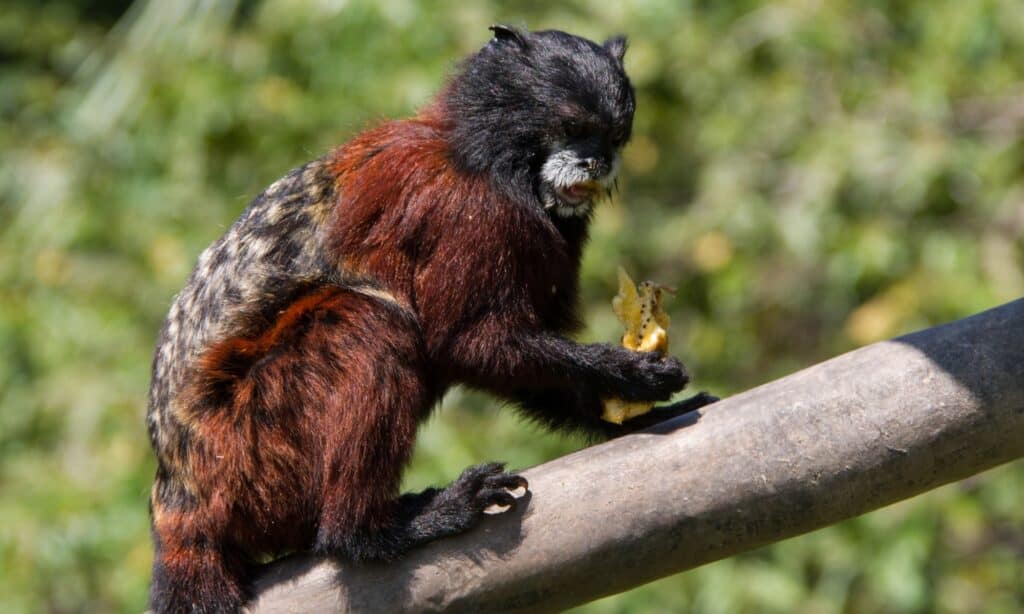
The saddle-back tamarin has saddle-like markings on its back.
©iStock.com/Micomyiza
The saddle-back tamarin (Leontocebus) is a small monkey in South America’s forests. Its name comes from the distinctive dark brown saddle-like markings on its back. This primate is a relatively small monkey, with an adult head-and-body length of around 7.7-8.1 inches and a tail length of about 17 inches. It weighs around one pound.
Saddle-back tamarins live in Brazil, Colombia, Ecuador, and Peru forests. They prefer primary rainforests but also inhabit secondary and swamp forests. It is an arboreal species, spending most of its time in the trees.
The saddle-back tamarin is an omnivorous species, feeding on fruit, small mammals, insects, and lizards. This primate will also eat bird eggs and nestlings.
The photo featured at the top of this post is © iStock.com/Ondrej Prosicky
Thank you for reading! Have some feedback for us? Contact the AZ Animals editorial team.




